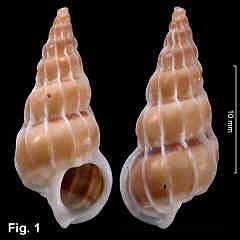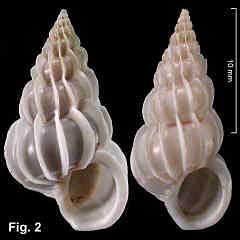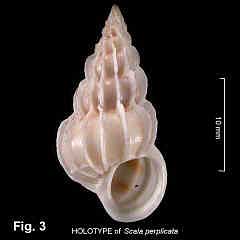|
|
|
|
|
Epitonium lamellosum (Lamarck, 1822) Description: Shell average width for genus, solid, variable in height to width ratio, whorls connected. Whorls rounded, sculptured with 9-15 strong axial ribs. Ribs aligned from whorl to whorl, folded backwards, not peaked. Interspaces smooth. Thin spiral rib at base, crossed by axial ribs. Aperture oval, outer lip with normal rib externally. Umbilicus closed. Colour white or fawn, with spiral brown band immediately below suture. Operculum corneous. Size: Australian specimens up to 35 mm in length, commonly about 20 mm. Distribution: Mediterranean and tropical Atlantic to Angola; southern Africa from Jeffreys Bay eastwards; Indo-Pacific, from southern Africa to California. (Kilburn, 1985). In Australia, Rottnest Is., south-western WA, around northern Australia, to Mallacoota, Victoria. Habitat: Most specimens in the Australian Museum collection are from beach washup, but Kerslake (1968) gave the habitat as "Shells on the east coast [of Australia] are found on rocky platforms exposed to the ocean; live specimens have been collected in the sand lying in shallow gutters between tide levels". In Japan, it lives on or around sea anemones on rocks in the intertidal zone to 10 m deep (Okutani, 2000). Uncommon in NSW. Comparison: This is a very distinctive species among the NSW epitoniids. The umbilicus is closed, there is a spiral rib on the base of the body whorl, and a brown band is present at the top of whorls. Synonymy: This species has been known in the Indo-West Pacific as Scalaria perplexa Pease, 1867, which is a synonym. Scala perplicata Iredale, 1929 is a synonym based on a typical shell of the species from Malacoota, Victoria (Fig. 3). Scala reevesbyi (Cotton, 1939) appears to also be a synonym (Kerslake, 1968). Remarks: This species has an unusually wide distribution, occurring in the Mediterranean and tropical Atlantic, and throughout the whole tropical Indian and Pacific Oceans. Although it was recognised as a single species across this wide distribution in the 19th century, regional names have continued to be used by some authors, including Wilson (1993) in Australian Marine Shells. Fig. 1: Bradleys Head, Sydney Harbour (DLB5153, protoconch missing) Fig. 2: Variation in shape. Angourie Point, NSW (C.361552, both specimens) Fig. 3: HOLOTYPE of Scala perplicata Iredale, 1929. Mallacoota, Victoria (C.050457) |


